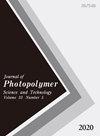PVA辊刷清洗时的结瘤变形及其与交叉污染的关系
IF 0.7
4区 化学
Q4 POLYMER SCIENCE
Journal of Photopolymer Science and Technology
Pub Date : 2021-06-11
DOI:10.2494/photopolymer.34.505
引用次数: 2
摘要
本研究研究了PVA辊刷擦洗过程中结核的变形和接触面积,以阐明它们与交叉污染的关系。我们利用两台高速摄像机,通过准直LED光源和棱镜上的倏逝场,观察电刷结节的变形和接触面积。变形分析表明,滚筒式电刷的体积在压缩开始时逐渐变化,在最大压缩时垂直推压变形较大,压缩结束后迅速恢复。电刷接触面积根据电刷和晶圆的转速而变化。接触区域可分为三种:前、后侧面在毛刷移动方向上,以及垂直推底面在表面上。在100mm晶圆片上分析了三种类型的电刷接触,发现垂直压缩类型对交叉污染区域有显著影响。本文章由计算机程序翻译,如有差异,请以英文原文为准。
Nodule Deformation on Cleaning of PVA Roller Brushes and its Relation to Cross-contamination
This study investigates nodule deformation and contact area during PVA roller-type brush scrubbing to clarify their relationship with cross-contamination. Two high-speed video cameras with collimating LED light sources and an evanescent field on a prism enabled us to observe brush nodule deformation and contact area. Deformation analysis showed that the volume of a roller-type brush changes gradually at the beginning of compression, deforms more when vertically pushed at maximum compression, and then recovers rapidly at the end of compression. The brush contact area changes according to the brush and wafer rotation speed. The contact area can be categorized into three: the front, rear side face in the brush traveling direction, and vertically pushed bottom face on the surface. We analyzed the three types of brush contacts on a 100 mm type wafer and observed that the vertical compression type significantly affected the cross-contamination region.
求助全文
通过发布文献求助,成功后即可免费获取论文全文。
去求助
来源期刊
CiteScore
1.50
自引率
25.00%
发文量
0
审稿时长
4-8 weeks
期刊介绍:
Journal of Photopolymer Science and Technology is devoted to the publication of articles on the scientific progress and the technical development of photopolymers.

 求助内容:
求助内容: 应助结果提醒方式:
应助结果提醒方式:


